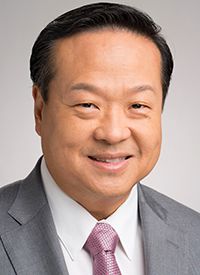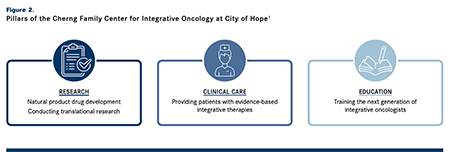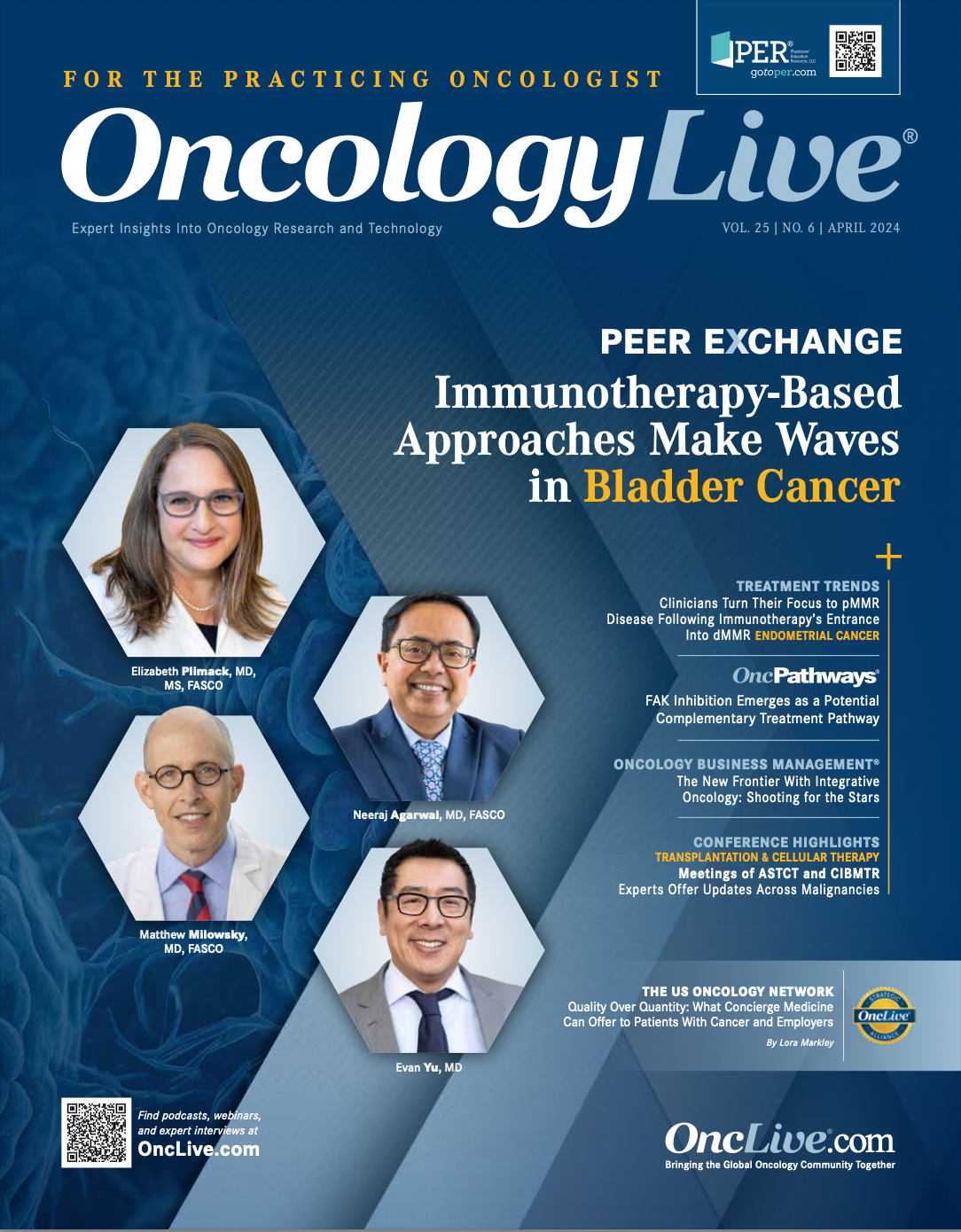Publication
Article
Oncology Live®
The New Frontier With Integrative Oncology: Shooting for the Stars
Author(s):
Key Takeaways
- City of Hope's Cherng Family Center focuses on research, clinical care, and education to advance integrative oncology.
- Integrative therapies, including acupuncture and ginger, show promise in managing cancer-related symptoms like pain and nausea.
Richard T. Lee, MD, and Edward S. Kim, MD, MBA, discuss the benefits of integrative oncology and exploring integrative approaches at the Cherng Family Center for Integrative Oncology at City of Hope.
Richard T. Lee, MD

Integrative oncology approaches spanning the full treatment spectrum for patients—during diagnosis, throughout treatment, and leading into survivorship—are different for each patient and have been long discussed, but the level 1 research needed to find new therapies and determine optimal approaches is just beginning. At City of Hope in Orange County, California, a first-of-its-kind center is breaking ground by examining the pillars of research, clinical care, and education, with the goal of discovering new approaches to better the standard of care (SOC), provide the groundwork to create programs that community centers can replicate, and train the next generation of oncologists.1
“In our research arm, we are very interested in natural product drug development and continuing that tradition—it’s estimated that 30% to 40% of FDA-approved chemotherapies come from plants,” Richard T. Lee, MD, said in an interview with OncologyLive. “We believe there’s a lot more yet to be discovered and in the laboratory we’re going to be focusing on looking at plant extracts to identify the next paclitaxel-type agent.”
Figure 1

First isolated from the bark of Taxus brevifolia (the Pacific yew), paclitaxel has tacked on approvals for the treatment of several cancers since its initial approval by the agency in 1992 for advanced ovarian cancer.2 Docetaxel is another chemotherapy derived from plants, specifically Taxus baccata (the European yew) and topotecan is a semisynthetic analogue of camptothecin, a chemical derived from Camptotheca acuminata (Chinese happy tree) (Figure 1).2-4
Lee, along with Edward S. Kim, MD, MBA, have begun efforts in and outside of the laboratory to build a world-class integrative oncology program and are leading the Cherng Family Center for Integrative Oncology at City of Hope. The center was aided and accelerated by a $100 million gift from the Panda Charitable Family Foundation created by the founders and CEOs of the national restaurant chain Panda Express, Andrew and Peggy Cherng. Integrative oncology therapies offered to patients at the center include art and music therapy, yoga, acupuncture, mind-body approaches such as meditation, and massage therapy.5
Edward S. Kim, MD, MBA

“Integrative oncology is a complementary way to incorporate Eastern techniques with Western techniques, encompassing mind, body, and soul—that holistic approach,” Kim explained in the interview. “It allows us to be open-minded in different techniques that have the same goal in mind, which is to deliver the best care to a patient, not only treating the cancer with various drugs or techniques but more importantly treating the patient as a whole. [We are asking]: What are the things that worry them before or during treatment? What are the issues that are going to exist in survivorship?”
New Guidelines Start the Conversation on Incorporating Integrative Techniques
The Society for Integrative Oncology (SIO) Clinical Practice Guidelines, first released in 2007, are the only comprehensive evidence-based guidelines for incorporating complementary and integrative therapies into the conventional clinical practice of oncology. Most recently, in 2022 SIO released joint clinical practice guidelines with the American Society of Clinical Oncology (ASCO) that identified 227 relevant studies which informed the evidence-based recommendations for integrative therapy in cancer care.6,7
“One of the first guidelines that came out was for pain and noted that acupuncture and acupressure can help patients with pain symptoms, as [can] mindfulness-based meditation techniques,” Lee explained. “These kinds of techniques help patients relax.”
The joint guidelines cited that clinicians should recommend acupuncture specifically for adults with aromatase inhibitor-related joint pain, and the complementary therapy, reflexology, or acupressure can also be recommended for general cancer pain or musculoskeletal pain. Regarding procedural pain, hypnosis may be offered, and pain experienced during palliative or hospice care can also include massage. However, these recommendations were of moderate strength and based on an intermediate level of evidence of benefit outweighing risk.7
“We have a lot of anecdotal research that’s being done and it’s not driving this level 1 evidence so that the payers have to provide coverage. Our big goal is to be the institute that leads that,” Kim said. “Other institutes in the country are trying to do this, and we will all work together as a team, but we feel that [with] the opportunity we have—with the establishment of the Cherng Family Center for Integrative Oncology, Dr Lee as our leader of the center, and City of Hope, which is a top 10 cancer center with over 40 sites in the country including campuses in Duarte; Irvine, California; Chicago, Illinois; Atlanta, Georgia; and Phoenix, Arizona—our potential impact will be great in this field.”
“Our hope with [the 3 pillars of the center] is that eventually [our work will] lead to large randomized controlled trials that then inform guidelines, such as the SIO/ASCO guidelines, so that in the future when they update those guidelines, they’ll see there’s more research demonstrating there’s now high-quality instead of intermediate- or low-quality evidence that demonstrates the value of these types of programs,” Lee added.
Acupuncture Makes Its Mark and Ginger Shines
Data from the randomized phase 2 IMPACT trial (NCT04095234) revealed that, for sessions spanning up to 26 weeks, patients with advanced cancers who received acupuncture (n = 298) experienced a reduction in worst pain score with a mean change of −2.53 points (95% CI, −2.92 to −2.15). Additionally, those who received massage therapy experienced a reduction in the Brief Pain Inventory worst pain score with a mean change of −3.01 points (95% CI, −3.38 to −2.63). Adverse effects (AEs) including bruising (6.5%) and transient soreness (15.1%) occurred in patients who received acupuncture and massage, respectively. Fatigue, insomnia, and quality-of-life (QOL) were all improved with both therapies.8
“There are also data on helping patients with nausea by using acupuncture and natural plant derivatives such as ginger, which has been shown to help reduce nausea in randomized controlled trials,” Lee noted. “These types of integrative therapies are a great way to complement many of the SOC options that we have and provide even further benefit in controlling these symptoms and allowing patients to have a better QOL as they go through treatment and head into survivorship.”
In a multicenter, double-blind, randomized trial (ACTRN12616000416493p), chemotherapy-naive patients who were scheduled to receive moderately to highly emetogenic chemotherapy received 4 standardized ginger capsules totaling 84 mg of active gingerols/shogaols daily (n = 52) or placebo (n = 51). Findings from the study demonstrated that there were clinically meaningful reductions in delayed nausea at cycle 2 in the ginger (53%) vs placebo (75%) groups (P = .020) and in vomiting, at 4% vs 27%, respectively (P = .001). At cycle 3, clinically meaningful reductions were also observed regarding delayed nausea (49% vs 79%; P = .002) and vomiting (2% vs 23%; P = .001).9
“I found that patients who might have refractory or chronic pain or refractory nausea for which SOC therapies may not be helping enough will often come back [following acupuncture] and say, ‘Wow, my nausea is 50% decreased.’ Or patients who can’t sleep at night who have stress and anxiety and have already been on 2 or 3 sleep aids that are not helping [have expressed they experienced benefit with integrative oncology],” Lee said. “I say, ‘Let’s try some stress management with deep-breathing exercises or meditation,’ and patients come back a month later and say, ‘I don’t need those prescription sleep medicines anymore because I’m meditating at night for 10 minutes and I’m getting much better sleep. I don’t have any of the AEs.’”
Additional Mind-Body Therapies: Managing Emotional Changes
“The integrative therapies that we will be providing [at the City of Hope center] for which there’s good evidence will include acupuncture, massage, mind-body medicine, music therapy, and art therapy. I have seen that all these therapies have had a major impact on patient care in different ways,” Lee said.
Results from a randomized study (NCT03683420) showed that adult patients who received outpatient chemotherapy infusions (n = 750) experienced significant benefit from preintervention to postintervention in improved positive mood and reduced negative mood and distress—not pain—when they listened to up to 60 minutes of self-selected music from a single genre compared with when no music was listened to (all 2-sample t-tests; P < .05).10
“Thinking about stress management techniques—guided imagery, hypnosis, yoga, and meditation—there’s a variety of these mind-body techniques that can be very beneficial for patients to help reduce the stress and anxiety that comes through the cancer journey, and we don’t have to depend on a prescription to help them sleep better at night,” Lee added. “If patients come in with symptoms such as pain, I may talk to them about acupuncture as well as using techniques such as massage or music therapy to help reduce symptoms. These are some of the common integrative therapies and it’s a personalized approach depending on their needs and what they’re experiencing.”
Further, a pilot noncontrolled descriptive study (NCT02659345) conducted at Case Comprehensive Cancer Center in Cleveland, Ohio, examined the impact of an hour-long art therapy session among 50 patients with cancer. Four visual analog scales (VAS) were used to assess pain, emotional distress, depression, and anxiety, and patients completed the scales prior to treatment, following treatment, and 48 to 72 hours after therapy. Following therapy, a decrease in VAS scores occurred but was low for pain and depression upon follow-up.11
Back to the Basics: Breaking it Down
“We focus on a lot of the basics of integrative oncology, which I would consider areas like nutrition,” Lee explained on how he treats patients. “I ask how we can optimize the foods that patients are eating to help reduce AEs and maintain their health and wellness. We talk about the role and importance of physical activity [as well]—patients often feel like because they’re going through treatment, they don’t need to be exercising, but in fact the data indicate the opposite, that they should maintain physical activity and remain active. This does not necessarily mean doing high-[intensity], vigorous activity, but even mild to moderate exercise can improve symptoms such as fatigue and improve tolerability for treatments.”
In their general physical activity recommendations for patients with cancer and cancer survivors, the American Cancer Society notes that regular exercise before, during, and after cancer treatment can reduce fatigue; help lessen depression and anxiety; improve muscle strength, bone health, and range of motion; reduce AEs; and may help with breast cancer–related lymphedema, among other positive attributes. The 2022 Nutrition and Physical Activity Guideline released for cancer survivors recommends that survivors build up to 150 to 300 minutes of moderate or 75 to 150 minutes of vigorous intensity activities each week.12,13 In its general guidelines, the American Cancer Society added that stretching exercises should be done biweekly and recommended the American College of Sports Medicine Moving Through Cancer initiative, which provides a booklet in English and Spanish for patients to reference on appropriate exercises.14
“I’ve found that patients are already using a lot of SOC therapies but [when] they start incorporating these integrative therapies, they’re able to come down on other treatments and get [good] if not better control of symptoms and improvement in QOL,” Lee said. “It’s surprising how often patients may want a new herb or supplement to try, and I say, ‘Let’s just focus on your nutrition and start exercising,’ and suddenly their energy levels are up and they can do things that they haven’t been able to do in the past 6 months. All these integrative therapies have great value and some of them are so simple, they’re often overlooked.”
Aiming to Bring Integrative Oncology to Community Practices
“What’s key about integrative oncology is its evidence-based approaches, and not every therapy is appropriate for every patient. We have to tailor it and make sure it’s personalized for both patient safety and efficacy issues,” Lee said.
“It is important to us to not only use the techniques that we have but also to perform the research that gets us to a point that these are recognized as SOC or not. Our pursuit in the center at City of Hope is not just to provide services—other institutions provide services and make these [therapies] available. We want to not only provide the services but pursue the new SOC, whether that is in cancer therapies, immunotherapies, cellular therapies, [or now] the new SOCs in integrative therapies,” Kim added.
Outside of the academic setting, Regional Cancer Care Associates—which has more than 25 locations throughout New Jersey, Connecticut, Maryland, and surrounding areas—offers the supportive therapies of yoga, spiritual support, nutrition counseling, massage therapy, and physical activity at their practices.15
“We need to demonstrate a sustainable clinical model that others can use [to] then start their own program,” Lee explained. “That’s oftentimes a criticism of large academic cancer centers as they have these programs, but [they are] hard to replicate because of their unique situation. We want to figure out a model that can be continued at other locations and is not unique to just City of Hope.”
When discussing how smaller practices could begin to implement various integrative oncology practices into care, Lee said it may be a matter of identifying staff with experience in certain therapies.
“There might be a nurse who has been trained in massage therapy or acupuncture, and [physicians can determine whether] there are any community practitioners with whom they may want to collaborate; if patients are interested in acupuncture or massage, [physicians can identify] somebody who is appropriately certified, trained, and they can work with them closely,” he noted.
What’s Next at City of Hope?
Lee noted that City of Hope is hosting the upcoming SIO 2024 Conference, which will be held from October 25 to 27 in Costa Mesa, California, 2024, and over 500 attendees from around the world will gather to discuss notable ongoing research in integrative oncology. The theme of the conference is “Full Circle Translational Integrative Oncology—From Bedside to Bench and Back.”
Figure 2

Along with Lee’s research in the laboratory on new plant-based therapies, and investigations on new integrative therapies/techniques, training is the third pillar of City of Hope’s Cherng Family Center for Integrative Oncology, where a program is being created to train the next generation of oncologists (Figure 2).1
“We’re hopeful that whenever someone is thinking about starting a program, they’re going to look at our program as an example and maybe even recruit one of [our] trainees to come lead their program. The only way we’re going to be able to increase accessibility of these important programs to more people is to do the rigorous level 1 research that’s needed to prove that there is a benefit of any particular area, whether it’s utilization of aromatherapy, music therapy, acupuncture, or any of the drugs that Dr Lee and his team would be studying,” Kim said. “If we’re rigorous, and we show the results are positive, then we would expect them to be on the guidelines, such as those of the National Comprehensive Cancer Network, and then payers would provide support to patients who want to have these services. That’s the gap right now that needs to [be filled].”
References
- Logsdon Z. City of Hope receives $100 million gift to create first-of-its-kind national integrative oncology program. News release. City of Hope. September 12, 2023. Accessed March 8, 2024. bit.ly/3v4Vl8I
- Khanna C, Rosenberg M, Vail DM. A review of paclitaxel and novel formulations including those suitable for use in dogs. J Vet Intern Med. 2015;29(4):1006-1012. doi:10.1111/jvim.12596
- Thirumaran R, Prendergast GC, Gilman PB. Chapter 7: Cytotoxic chemotherapy in clinical treatment of cancer. In: Prendergast GC, Jaffee EM, eds. Cancer Immunotherapy: Immune Suppression and Tumor Growth. Academic Press; 2007:101-116.
- Scholar E. xPharm: The Comprehensive Pharmacology Reference. IASLC Thoracic Oncology (Second Edition), 2018. doi:10.1016/B978-008055232-3.62785-0
- The Cherng Family Center for Integrative Oncology. City of Hope. Accessed March 8, 2024. bit.ly/3v3Ww8g
- Practice guidelines. Society for Integrative Oncology. Accessed March 8, 2024. bit.ly/3v3WDRe
- Mao JJ, Ismaila N, Bao T, et al. Integrative medicine for pain management in oncology: Society for Integrative Oncology–ASCO guideline. J Clin Oncol. 2022;40(34):3998-4024. doi:10.1200/JCO.22.01357
- Epstein AS, Liou KT, Romero SAD, et al. Acupuncture vs massage for pain in patients living with advanced cancer: the IMPACT randomized clinical trial. JAMA Netw Open. 2023;6(11):e2342482. doi:10.1001/jamanetworkopen.2023.42482
- Crichton M, Marshall S, Isenring E, et al. Effect of a standardized ginger root powder regimen on chemotherapy-induced nausea and vomiting: a multicenter, double-blind, placebo-controlled randomized trial. J Acad Nutr Diet. 2024;124(3):313-330.e6. doi:10.1016/j.jand.2023.09.003
- Harper FWK, Heath AS, Moore TF, Kim S, Heath EI. Using music as a tool for distress reduction during cancer chemotherapy treatment. JCO Oncol Pract. 2023;19(12):1133-1142. doi:10.1200/OP.22.00814
- Elimimian EB, Elson L, Stone E, et al. A pilot study of improved psychological distress with art therapy in patients with cancer undergoing chemotherapy. BMC Cancer. 2020;20(1):899. doi:10.1186/s12885-020-07380-5
- Physical activity and the person with cancer. American Cancer Society. Updated March 16, 2022. Accessed March 8, 2024. bit.ly/3T7O67Y
- Rock CL, Thomson CA, Sullivan KR, et al. American Cancer Society nutrition and physical activity guideline for cancer survivors. CA Cancer J Clin. 2022;72(3):230-262. doi:10.3322/caac.21719
- Moving through cancer. American College of Sports Medicine. Accessed March 8, 2024. bit.ly/3wM73p4
- Integrative care attacks cancer through a multifaceted approach. Regional Cancer Care Associates. Accessed March 8, 2024. bit.ly/3uZpaaF










